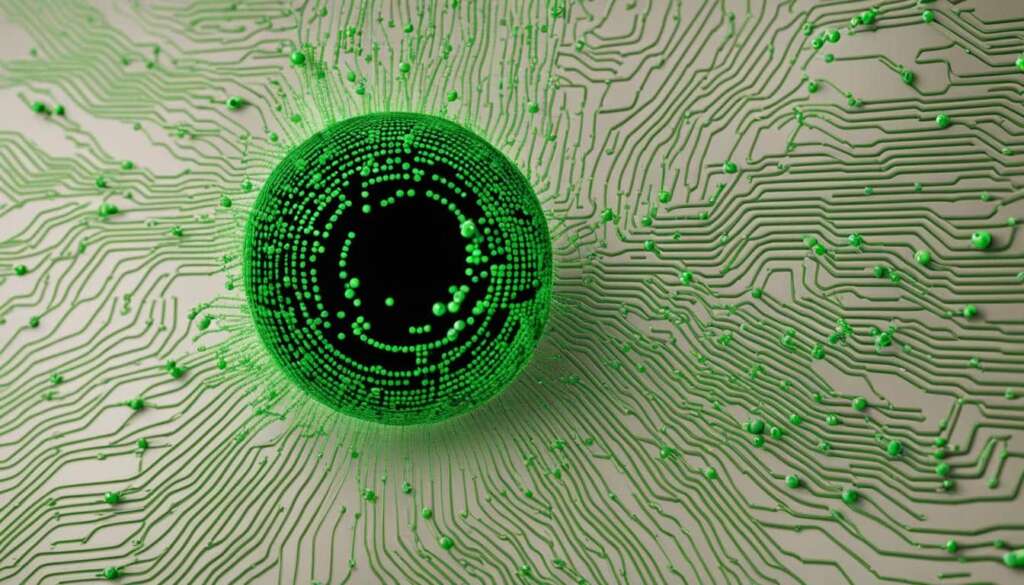Table of Contents
Welcome to our article on the history of the first computer virus in the Philippines. In this section, we will delve into the fascinating story of the “ILOVEYOU” virus, also known as the “Love Bug” or “Loveletter” virus. This significant event took place on May 4, 2000, and had a profound impact on the field of computer security.
Before we dive into the details, let’s take a moment to appreciate the significance of this milestone in Philippine computer history. The first computer virus, originating from our beloved country, put the Philippines on the map in the realm of cybersecurity.
This image beautifully captures the essence of the first computer virus, showcasing its profound impact on the digital landscape. Now, let’s delve deeper into the story of the “ILOVEYOU” virus and its consequences.
The Impact of the ILOVEYOU Virus
The emergence of the ILOVEYOU virus had a profound impact on computer security and cyberattacks, highlighting the vulnerabilities inherent in digital systems. As the virus rapidly spread across Asia, Europe, and North America, it infected over 45 million users within just ten days. The ILOVEYOU virus specifically targeted Windows-based computers running Microsoft Outlook, which was a widely utilized email client at the time.
The virus wreaked havoc by overwriting and deleting various files on the infected machines, leading to significant data loss and system instability. Furthermore, the ILOVEYOU virus exposed the susceptibility of computer systems to social engineering tactics, relying on enticing users to open the infected email attachment. This widespread damage caused organizations such as the United Kingdom’s House of Commons, the Ford Motor Company, and even Microsoft itself to shut down their email systems to mitigate the virus’s impact.
This event served as a wake-up call for both companies and security professionals, emphasizing the urgent need to prioritize user security awareness and education. The ILOVEYOU virus highlighted the potential dangers of social engineering tactics and spam emails, as unsuspecting users were enticed into opening the infected attachment under the belief that it contained a sincere love letter. This incident underscored the importance of user training and awareness to recognize and avoid such threats, propelling advancements in cybersecurity practices and the development of better tools and techniques to detect and prevent malware, spam, and phishing attacks.
“The ILOVEYOU virus underlined the vulnerability of computer systems to malware and the pressing need for improved cybersecurity practices.”
The Global Response to the ILOVEYOU Virus
The emergence of the ILOVEYOU virus sparked a global response and raised awareness about the need for legislation to address cybercrime. The virus received substantial media attention and prompted the cybersecurity community to take notice of the potential dangers posed by social engineering tactics and spam emails.
“The ILOVEYOU virus was a wake-up call for the world. It showed us how vulnerable our computer systems were and how easily we could fall victim to cyber attacks,” said cybersecurity expert Dr. Jane Andrews. “The incident highlighted the urgent need for governments and organizations to prioritize cybersecurity and implement measures to protect themselves and their users.”
As a result of the widespread damage caused by the ILOVEYOU virus, governments and organizations worldwide began to prioritize cybersecurity and implement measures to prevent future attacks. The incident led to the development of new laws and regulations, such as the E-Commerce Law in the Philippines, to address cybercrime.
| Year | Event |
|---|---|
| 2000 | The ILOVEYOU virus emerges, infecting millions of computer systems worldwide. |
| 2001 | The E-Commerce Law is enacted in the Philippines to address cybercrime. |
| 2002 | The Cybersecurity Enhancement Act is signed into law in the United States, aiming to strengthen the country’s cybersecurity infrastructure. |
| 2003 | The London Action Plan is established to enhance international cooperation in combating spam and cybercrime. |
The incident also prompted increased efforts in the field of computer programming and cybersecurity to develop better tools and techniques for detecting and mitigating the impact of malware and cyber attacks. Researchers and cybersecurity experts worked together to create more robust antivirus software and improve security measures.
Advancements in Computer Programming and Cybersecurity
The ILOVEYOU virus served as a catalyst for advancements in computer programming and cybersecurity practices. It exposed the vulnerabilities of existing systems and compelled programmers and cybersecurity professionals to develop innovative solutions to protect against future threats.
- Improved Email Filtering: Email service providers and organizations enhanced their email filtering capabilities to detect and block suspicious attachments and spam emails.
- Stronger Authentication Mechanisms: The incident highlighted the importance of strong authentication mechanisms, leading to the development of two-factor authentication and biometric security measures.
- Enhanced Malware Detection: Antivirus software and other cybersecurity tools were upgraded to better detect and prevent malware, including self-replicating worms like the ILOVEYOU virus.
These advancements in computer programming and cybersecurity have significantly contributed to the overall protection of computer systems and the prevention of future cyber attacks.
Lessons Learned from the ILOVEYOU Virus
The emergence of the ILOVEYOU virus served as a stark reminder of the importance of computer security and cybersecurity in protecting individuals and organizations from malicious threats. This event highlighted several crucial lessons that have shaped the way we approach digital security today.
Social Engineering and User Awareness
One of the key takeaways from the ILOVEYOU virus is the significant role that social engineering tactics play in cyber attacks. The virus was able to exploit human curiosity and emotions by disguising itself as a love letter, enticing users to open the infected email attachment. This incident demonstrated the need for comprehensive user training and awareness programs to educate individuals about the risks associated with clicking on suspicious links or opening unknown attachments. By empowering users with knowledge about common phishing techniques and the importance of verifying the authenticity of emails, organizations can reduce the likelihood of falling victim to similar attacks.
Advanced Spam and Phishing Detection
The ILOVEYOU virus also shed light on the need for more sophisticated spam and phishing detection mechanisms. As the virus spread through email attachments, it became evident that traditional email filters were not equipped to handle such a complex threat. Organizations and security professionals have since developed advanced spam filters and email security solutions to identify and block suspicious emails. These technologies employ machine learning algorithms and pattern recognition techniques to analyze email content, URLs, and attachments, helping to prevent malware infections and phishing attempts.
Continuous Adaptation and Vigilance
The ILOVEYOU virus demonstrated the importance of continuous adaptation and vigilance in the field of cybersecurity. As technology evolves, so do the tactics used by cybercriminals. Organizations and security professionals must remain proactive in their approach to cyber defense, keeping up with the latest trends and emerging threats. Regular security assessments, software updates, and employee training are essential to stay one step ahead of potential attackers. By adopting a proactive and vigilant mindset, organizations can better protect their digital assets and minimize the impact of future cyber attacks.
| Lessons Learned | Actions Taken |
|---|---|
| Social engineering and user awareness | Implemented comprehensive user training programs to educate individuals about phishing techniques and the importance of verifying email authenticity. |
| Advanced spam and phishing detection | Developed sophisticated email security solutions using machine learning algorithms and pattern recognition techniques to identify and block suspicious emails. |
| Continuous adaptation and vigilance | Adopted a proactive approach to cybersecurity with regular security assessments, software updates, and employee training to stay ahead of emerging threats. |
Conclusion
The emergence of the ILOVEYOU virus marked a significant milestone in the history of computer viruses and cyber attacks. It highlighted the vulnerability of computer systems to malware and the potential impact of social engineering tactics. The widespread damage caused by the virus prompted a global response and led to the implementation of improved cybersecurity practices and legislation to address cybercrime.
The ILOVEYOU virus served as a catalyst for advancements in computer security and cybersecurity practices. It underscored the need for constant vigilance and education to prevent future attacks and protect against evolving threats in the digital world. The lessons learned from the ILOVEYOU virus continue to influence the field of cybersecurity today.
As technology evolves, it is crucial for individuals and organizations to stay updated on the latest cybersecurity practices. Regular software updates, strong passwords, and cautious browsing habits can help mitigate the risk of malware and cyber attacks. By prioritizing user security awareness and implementing robust cybersecurity measures, we can create a safer digital environment for all.
The ILOVEYOU virus reminds us of the importance of maintaining a proactive approach to cybersecurity. By learning from past incidents and continuously enhancing our defenses against malware and cyber attacks, we can safeguard our digital assets and protect ourselves from potential threats.
FAQ
What was the ILOVEYOU virus?
The ILOVEYOU virus was a computer worm that emerged in the Philippines on May 4, 2000. It quickly spread globally, affecting millions of computer systems worldwide.
Who created the ILOVEYOU virus?
The ILOVEYOU virus was created by a Filipino computer programmer named Onel de Guzman as a part of his undergraduate thesis.
How did the ILOVEYOU virus spread?
The ILOVEYOU virus spread through email attachments with the subject line “ILOVEYOU.” When users opened the infected attachment, their computers became infected, and the virus could then spread to other systems.
What damage did the ILOVEYOU virus cause?
The ILOVEYOU virus caused widespread damage, affecting an estimated 45 million individuals and resulting in approximately $10 billion in damages. It overwrote and deleted files, caused data loss, and made infected systems unstable.
Did the ILOVEYOU virus lead to any changes in cybersecurity practices?
Yes, the ILOVEYOU virus had a significant impact on computer security. It prompted organizations and governments worldwide to prioritize cybersecurity and implement measures to prevent similar attacks. It also led to the development of new laws and regulations to address cybercrime.













